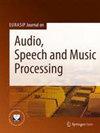通过无监督学习为音频事件检测进行多速率调制编码
IF 1.9
3区 计算机科学
Q2 ACOUSTICS
Eurasip Journal on Audio Speech and Music Processing
Pub Date : 2024-04-01
DOI:10.1186/s13636-024-00339-5
引用次数: 0
摘要
医疗保健、智能家居、安防、生态和娱乐领域的技术都采用了音频事件检测(AED)技术,以检测音频记录中的声音事件。有效的 AED 技术在很大程度上依赖于监督或半监督模型,以捕捉声音事件所跨越的广泛动态范围,从而实现时间上精确的边界和准确的事件分类。这些方法需要收集大量标注或弱标注的域内数据,成本高昂且劳动密集。重要的是,这些方法不能充分利用声音事件固有的可变性和动态范围,而这些方面可以通过无监督方法有效识别。本研究提出了一种基于多速率自动编码器的方法,该方法以无监督的方式对自动编码器进行预训练,以利用未标记的音频数据,最终学习自然声音事件中固有的丰富时间动态。这种方法利用并行自动编码器实现对不同频带调制频谱的分解。此外,我们还引入了速率选择性时态对比损失,使训练目标与事件检测指标保持一致。通过优化多速率编码器的配置和时间对比损失,在 DCASE 挑战赛的背景下,国内声音事件检测有了显著改善。本文章由计算机程序翻译,如有差异,请以英文原文为准。
Multi-rate modulation encoding via unsupervised learning for audio event detection
Technologies in healthcare, smart homes, security, ecology, and entertainment all deploy audio event detection (AED) in order to detect sound events in an audio recording. Effective AED techniques rely heavily on supervised or semi-supervised models to capture the wide range of dynamics spanned by sound events in order to achieve temporally precise boundaries and accurate event classification. These methods require extensive collections of labeled or weakly labeled in-domain data, which is costly and labor-intensive. Importantly, these approaches do not fully leverage the inherent variability and range of dynamics across sound events, aspects that can be effectively identified through unsupervised methods. The present work proposes an approach based on multi-rate autoencoders that are pretrained in an unsupervised way to leverage unlabeled audio data and ultimately learn the rich temporal dynamics inherent in natural sound events. This approach utilizes parallel autoencoders that achieve decompositions of the modulation spectrum along different bands. In addition, we introduce a rate-selective temporal contrastive loss to align the training objective with event detection metrics. Optimizing the configuration of multi-rate encoders and the temporal contrastive loss leads to notable improvements in domestic sound event detection in the context of the DCASE challenge.
求助全文
通过发布文献求助,成功后即可免费获取论文全文。
去求助
来源期刊

Eurasip Journal on Audio Speech and Music Processing
ACOUSTICS-ENGINEERING, ELECTRICAL & ELECTRONIC
CiteScore
4.10
自引率
4.20%
发文量
0
审稿时长
12 months
期刊介绍:
The aim of “EURASIP Journal on Audio, Speech, and Music Processing” is to bring together researchers, scientists and engineers working on the theory and applications of the processing of various audio signals, with a specific focus on speech and music. EURASIP Journal on Audio, Speech, and Music Processing will be an interdisciplinary journal for the dissemination of all basic and applied aspects of speech communication and audio processes.
 求助内容:
求助内容: 应助结果提醒方式:
应助结果提醒方式:


